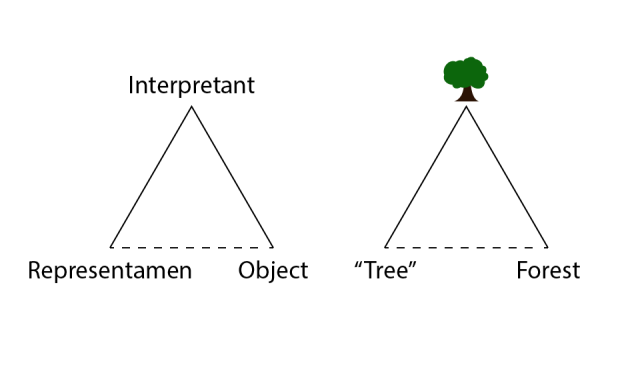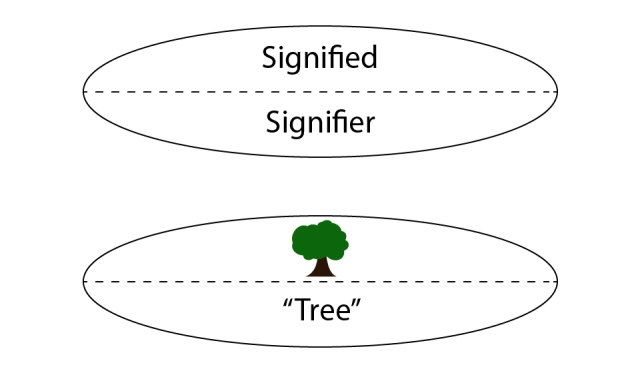So Simone’s lecture this week was certainly helpful. In it, she briefly introduced us to several academic theories which many students will likely find useful. In doing so she made me realise a massive oversight I had made: I had completely forgotten about Semiotics Theory. Semiotics is relevant to all artists who want to add meaning and depth to their work. But for me especially I needed to remind myself of the theory because it is the foundation of Shared Vocabulary, which is a Visual Indicator in Character Design. To this end, after the lecture I picked up Semiotics: the Basics, by Daniel Chandler.
Semiotics Theory is, in the simplest sense, the “study of signs” (p. 1). The theory refers to studying anything which ‘stands for’ something else, which can refer to “words, images, sounds, gestures, and objects” (p. 2). So long as it connotes something, Semiotics studies it. Whilst much of the field is focused on language, vocabulary and literature, the methodology can be applied to other forms of communication such as imagery (hence the relevance to me).
Indeed, philosopher Susanne Langer argued that whilst they have “no vocabulary of units with independent meanings“, visual media is still “abstractable and combinatory” and equally capable of articulation (pp. 6- 7). Articulation is the formation of a semiotic code to create meaningful combinations between these smaller units which lack independent meaning. Langer then takes this further and, unlike other studiers of Semiotics and dismissing non-discursive media, and argues that “they are more complex and subtle than verbal language and are ‘peculiarly well-suited to the expression of ideas that defy linguistics “projection’”” (p. 7)
There are two widely recognised models for Semiotics theory: the Saussurean model and the Peircean model. The Saussurean model, proposed by Ferdinand de Saussure, focused on linguistic signs and defined them as composing of a “signifier” (significant) and a “signified” (signifié). The signifier refers to the form the sign takes. The signified is the concept to which the sign refers.
The Peircean model was proposed by Charles Sanders Peirce around the same time as Saussure proposed his. Peirce’s model is very similar to Saussure’s albeit with different terms and the inclusion of a third facet. The Peircean model is comprised of an “representamen“, an “interpretant“, and an “object“. The representamen is the form with the sign takes, and is the Peircean equivalent of the signifier. The interpretant the sense made of the sign, an equivalent sign created by the representamen. The object is something which the interpretant stands for or references.

A visual representation of the Peircean model, although Peirce himself never designed such a visual. The broken line indicates there is not necessarily a link between the representamen and object, but that one might exist.
Personally, I prefer Peirce’s model for Semiology and find it easier to understand than the Saussurean model. Peirce’s model offers support to more complex relationships within visuals, thanks to the triadic structure being more flexible. Furthermore, while each model supports the notion that one sign the can lead into a new sign via it’s signified/interpretant, I find Chandler’s description and visualisation of the Peircean method much easier to wrap my head around. In the Peircean model it is suggested that the interpertant of a sign can lead into a new representamen, which creates a new interpretant, which can lead into a new representamen, and so on. This can be visualised as shown below.
Despite their differences, from Chandler’s writings it seems that the theories within semiotics can be applied more or less to each model. Thus I will be continuing to look into Semiology using Peirce’s model as a reference simply because I find it easier to understand and visualise the connections in my head.
After explaining the two common models for Semiology , Chandler then briefly discusses the common modes which signs conform to: Symbolic, Iconic, and Indexical. I have made a note of the differences between each of these modes, but I am not sure how useful I will find it. It certainly opened my eyes to the complexities of signs, but the operation of each mode does not affect the overall function of the model and so I don’t think it will have a large impact on my research.
What I think will be important however is Chandler’s discussion of the Whorfian hypothesis (also known as Sapir-Whorf Theory), pioneered by Edward Sapir and Benjamin Lee Whorf. This thesis stems from the argument of constructionist theorists who say that “linguistic codes play a key role in the construction and maintenance of social realities” (p. 153). We learn about the world around us through the codes by which we structure.
The Whorfian thesis suggests that “people who speak languages with very different phonological, grammatical and semantic distinctions perceive and think about the world quite differently, their worldviews being shaped or determined by their language” (p. 153). Although the extreme nature of the hypothesis has led to critics rejecting it in it’s extreme determinism. “we cannot make inferences about differences in worldview solely on the basis of differences in linguistic structure” (p. 153). However, many linguists do accepts a weaker form of the Whorfian thesis which implies that a person’s view of the world is influenced by the kind language they use rather than dictated by it.
This can be seen in visuals as well. Many cultures have different responses to languages based on various reasons. Although never specifically discussed, this has been mentioned in passing in many of the character designs books I have read (such as Virtual Character Design) as a warning to artists of unforeseen consequences.
Certainly, Semiotics: the Basics has been a useful piece of reading for this project. The discussions of the Whorfian thesis and the modes of signs have certainly provided me with a new way of approaching signs in my work, and whilst it might not manifest in a spectacular fashion, I do believe it will subtly impact my use of visuals.
More importantly however was the introduction to the Saussurean and Peircean models for Semiology. I had always known of Semiotic theory as the study of signs and how they are interpreted, but just coasted by on this knowledge until know. With Chandler’s introduction to the models however, and more importantly the visualisations of each, I now have a better understanding of of the elements within a sign and how they interact with an audience. As I continue my readings into the nature of stereotypes I am starting to think that they might follow a structure similar to Peirce’s model, or which can be integrated into it. It will take some trial and error and a lot of case studies, but I think the Peircean model of Semiology will play an important role in helping me understand how stereotypes are constructed and how they function when we are presented with them.
Chandler, D. 2007. Semiotics: the basics. 2nd ed. London: Routledge

